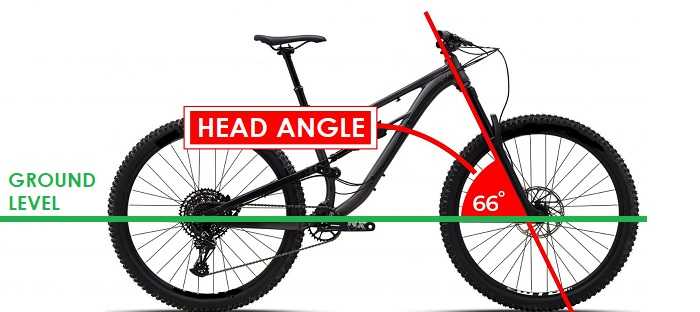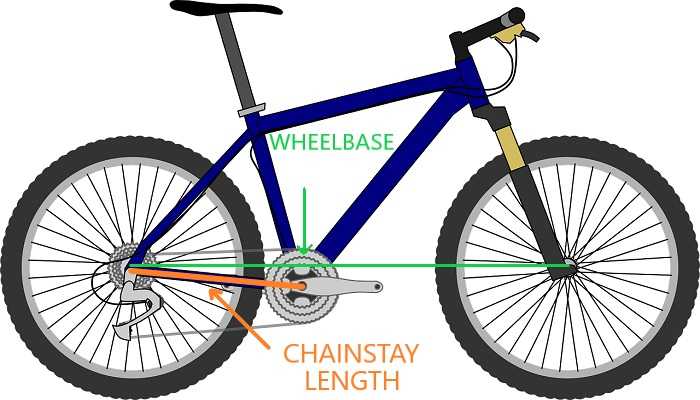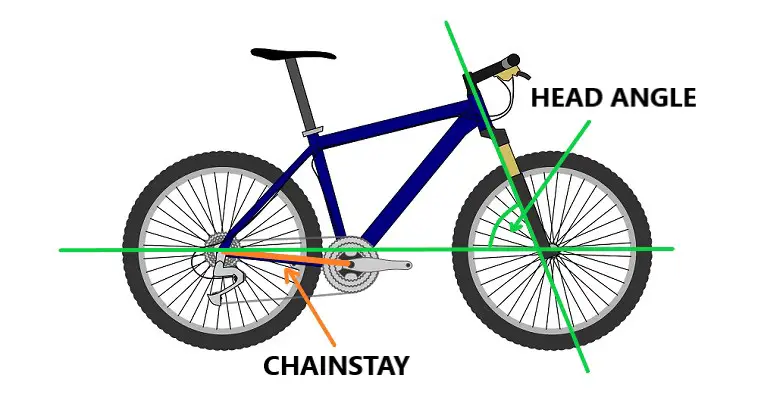Bicycles are not just about two wheels and a frame. They are fascinating machines consisting of numerous components that affect how you ride. Two of the most vital components on a bike are the head angle and chainstay length, which shape your biking experience. These two are the secret sauce for a bicycle to work efficiently.
People usually get confused between these two terms, and it is natural to feel so. However, I’m here to help you and break down the two in this article to let you enjoy your next ride. Let’s begin!
What is a head angle on a bike?

Take the example of a shark, think of it as your bike, and the head angle is its snout (long projecting nose). The head angle can be described as the angle between the ground and an imaginary line that spans from the center of the head tube of the bike (the part that holds the front fork) to the center front wheel’s axle.
I hope you got it.
Head angle degrees/types
When we talk about head angles, they are measured in degrees. They can range typically within 65-74 degrees with slacker angles on the higher end and steeper on the lower end angles.
Here’s a slight breakdown –
| HEAD ANGLE TYPE | IDEAL FOR |
|---|---|
| Steep (70-74 degrees) | Take it as your bike’s espresso shot, which is fast and nimble. It is ideal for technical trails and tight turns. |
| Neutral (67-69 degrees) | They are known to be versatile across different terrains and are a balanced choice. |
| Slack (65-67 degrees) | This can be called as the bike’s hammock – stable and relaxed. Slacker angles are perfect for rough terrains and downhill thrills. |
How head angle type impacts the ride (steeper vs slacker)
Here’s how head angle shapes your bicycle ride –
| STEEPER HEAD ANGLE | SLACKER HEAD ANGLE |
|---|---|
| Fast & nimble: Steeper angles allow faster response of the bike to steering input. It is somewhat similar to the bike having super sensitive brakes. | Stability champ: These angles have a lot of stability during high speeds. You can refer to having it on auto-pilot mode on a straight highway. |
| Racer’s favorite: Cross-country riders are known for their preference towards steeper angles due to their control and accuracy. | Enduro dream: Slacker angles have always been the top choice for enduro enthusiasts due to their stability and agility. |
| Agile: As you can easily maneuver through tricky sections, they are ideal for climbing. | Downhill fun: Downhill riders prefer slacker angles for taking on gnarly descents confidently. |
Mountain bike type and its head angle
Similar to different species of sharks, bikes are of different types as well. The type of bike determines its head angle –
| XC (Cross-Country) | Such bikes generally consist of steeper angles for demanding actions and agility. |
| Enduro | Enduro bikes are towards the slacker side for downhill actions as a lot of stability is required. |
| Trail bikes | Such bikes have a sweet spot with balanced angles that are suitable for a range of terrains. |
| Downhill bikes | They are all for slack angles to get maximum control during top speed. |
Which head angle to select?
Choosing the ideal head angle can come down to your preferred terrain and riding style. Here’s a quick cheat sheet –
- Steeper head angles: Such head angles would be the best when you’re a rider fond of technical trails. If you like to be precise about your riding, you can opt for this.
- Slacker head angles: In my opinion, bike riders who need a bit of stability during high-speed runs can go for slacker head angles.
What is a chainstay on a bicycle?

If I had to make it creative, think of them as the legs of a bike, this is because they connect the bottom bracket to the rear wheel’s axle. It is what helps the bike to be balanced and keeps it stable. The chainstay is the entire stretch of the frame between your pedals and the axle of the back wheel.
When you are talking about mountain bike chainstay lengths, they are measured in millimeters. They can range from short (410mm) to long (432mm or more). The short one can be described as sprinter’s legs, while long chainstays can be compared to a marathon runner’s legs.
Impact of chainstay length on bike ride
| SHORT CHAINSTAY | LONGER CHAINSTAY |
|---|---|
| Maximum agility – Short chainstays make the bike feel nimble and full of pace. It does feel like having a sports car for tough corners. | Super stability – At high speeds, longer chainstays provide more stability. This can be similar to cruising on an extremely comfortable sofa down the highway. |
| Technical wizard – In technical aspects like quick maneuvers, they shine and are ideal for it. | Uphill power – As they improve traction immensely, climbing is quite an easy task with longer chainstays. |
Mountain bike type and its chainstay length
Similar to people having different leg lengths, bikes do tend to have different chainstay lengths as per their intended use. The different types of them are as follows –
| BIKE TYPE | AVG. CHAINSTAY LENGTH |
|---|---|
| XC (Cross-Country) | 419mm – These kinds of bikes prefer shorter chainstays on tricky trails due to their agility. |
| Downhill | 445mm – They prefer to rock the longest chainstays for better stability. |
| Enduro | 432mm – These bikes go for a slightly longer one to take care of speed while also maintaining agility. |
| Trail | 433mm – Trail bikes find balance in chainstay lengths, which provides a lot of versatility on numerous terrains. |
Choosing the correct chainstay length
I said the same about head angle earlier, and this holds for chainstay lengths too. It all depends upon your terrain preference and style of riding. Here’s a small tip –
- Short chainstays – If you prefer smooth handling and trails that are technical, this is for you.
- Longer chainstays – Riders who want more of stability during high speeds can rock longer chainstays.
Head angle vs chainstay length
As I have talked about head angles and chainstay lengths in detail, it is time to turn toward the combination.
- Steeper head angle + shorter chainstays – Such a combination can provide agility and precision. These can be the secret sauce for perfect technical rides.
- Slacker head angle + longer chainstays – This can be the correct mix for control on high-speed descents and stability too.
- Mix around: Mixing and matching can let you find that sweet spot. Look at different chainstay lengths and head angles to find your ideal combination.
In conclusion
I think you’re ready to rock the roads with your knowledge about head angles and chainstay lengths. Remember, it is all about finding the perfect balance for your bike riding style and the type of terrain you want to explore.
What is stopping you now? Get the head angles and ideal chainstay lengths to get back on your bike journey.
Also read – Electric Bikes Size Guide

